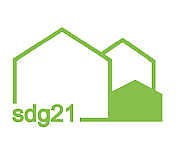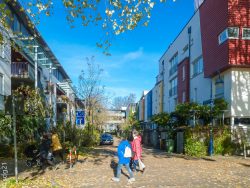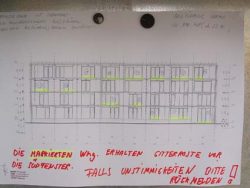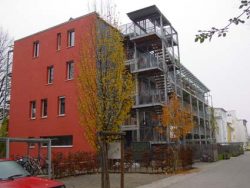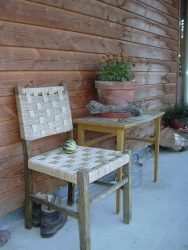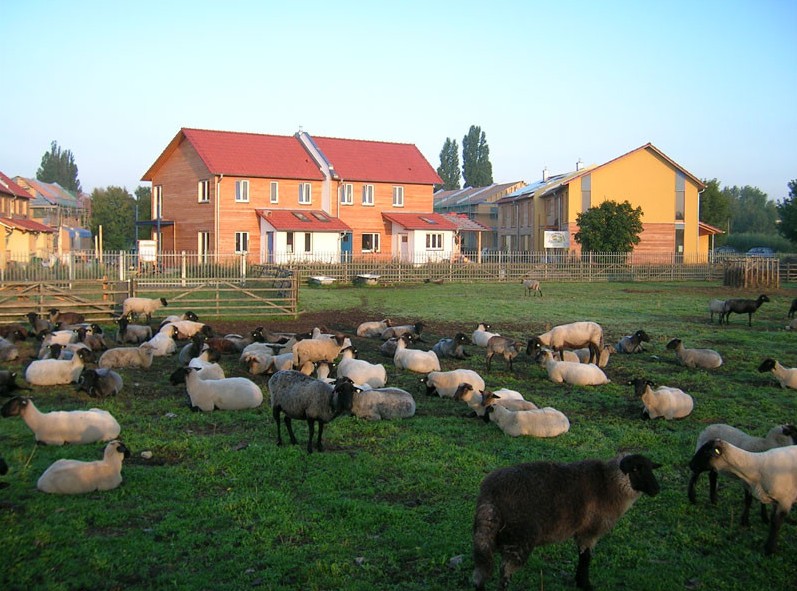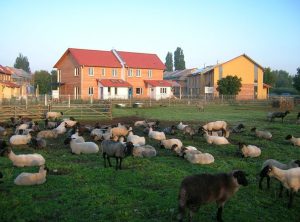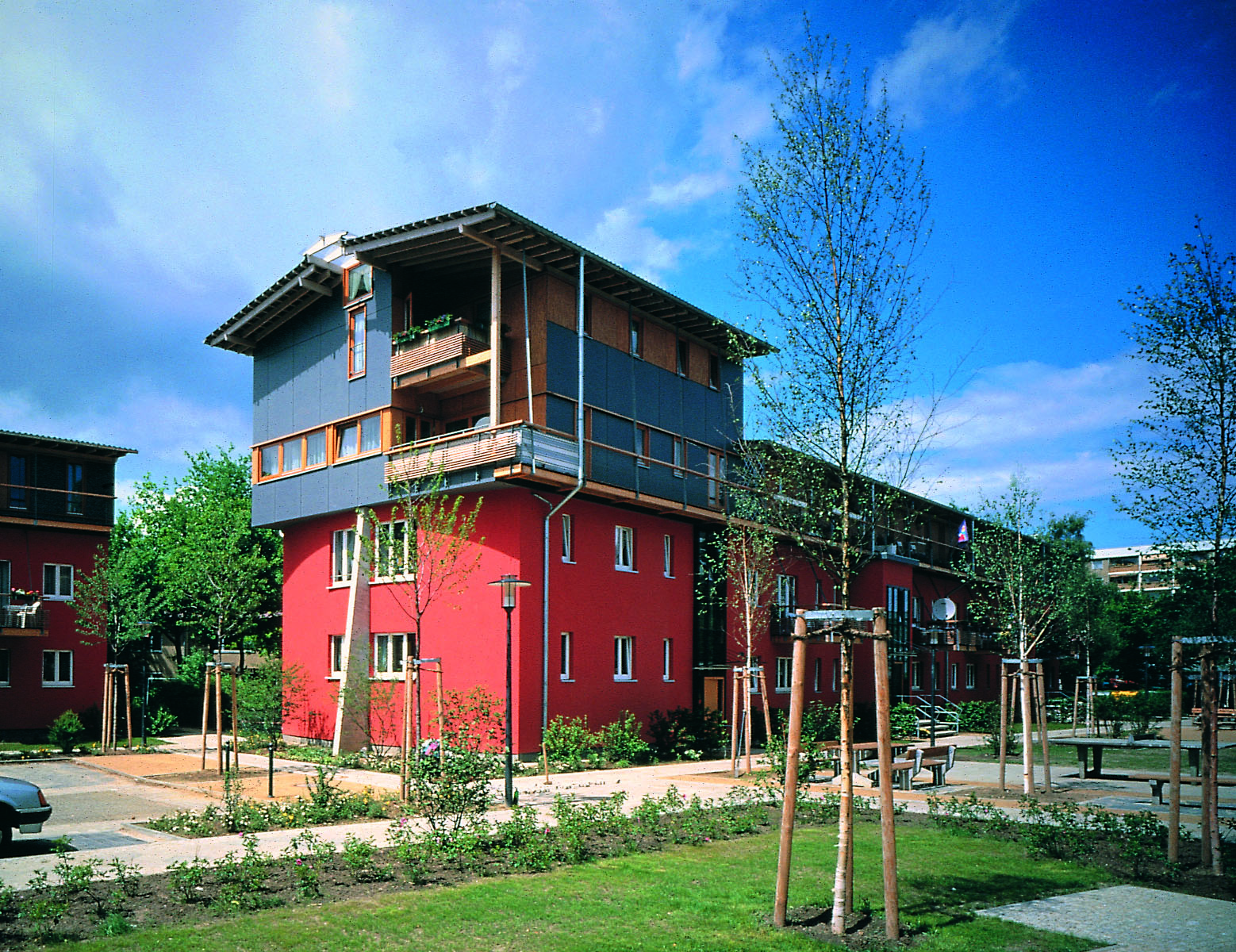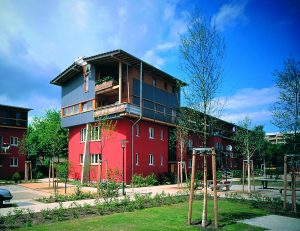 79100 Freiburg-Vauban: extended citizen participation through the Forum Vauban, car-free living, public transport, car sharing, mixed use, solar garage, local heating with CHP units, nature-oriented open space design, building biology and ecological materials. 40% of households live without their own car. The number of parking spaces for the entire quarter is 0.42 PkW/WE. Large-scale completion: 2012
79100 Freiburg-Vauban: extended citizen participation through the Forum Vauban, car-free living, public transport, car sharing, mixed use, solar garage, local heating with CHP units, nature-oriented open space design, building biology and ecological materials. 40% of households live without their own car. The number of parking spaces for the entire quarter is 0.42 PkW/WE. Large-scale completion: 2012
The Vauban district is not a car-free district, but a car-reduced district. The traffic concept provides for a gradation from the surrounding, superordinate streets (50 km/h) to the main access road of the quarter, the Vauban-Allee with managed parking (30 km/h), the calmed residential streets without public parking spaces (walking speed) to the supplementary pedestrian/cycle path system and the pure pedestrian areas. The traffic-calmed residential streets are available for various open space uses, for recreation and for largely safe children's play.
| Street | Merzhauser Straße/ Vauban, Freiburg |
| Building type | Apartment buildings and terraced houses |
| New construction, renovation | New building on former barracks site |
| Form of ownership | Condominiums, cooperative housing, rental apartments, commercial buildings |
| Location: | Vauban lies in a scenic location at the exit of the Hexental, at the foot of Schönberg and Lorettoberg, in the direct vicinity of the municipality of Merzhausen. |
| Size | 2,591 residential units. Number of residents at the end of 2013: 5,661 Approx. 600 workplaces |
| Area including SUSI and student union: 41 hectares New construction area (excluding student union and SUSI): 34 hectares (Source: https://freiburg-vauban.de/... Accessed 5/2018) |
|
| Completion | Duration of the marketing of the plots: 1997-2012 |
| Sustainability measures |
||
| Urban planning | Mostly new buildings with multi-storey apartments. Approx. 600 jobs in buildings on the edge of the neighbourhood. Few mixed-use buildings. In 1994, the city of Freiburg launched an urban planning ideas competition, which was won by the office Kohlhoff u. Kohlhoff (Stuttgart). | |
| Ecology | ||
| Energy | Low energy, passive house or plus energy house standard. Local heating with highly efficient woodchip CHP and solar systems, solar garage | |
| Building materials | Varying high proportion of building organic and ecological materials. Some wooden buildings. | |
| Building Biology | The planning office EMP / JEA, which stands for a healthy living construction method, has realised several building projects on the Vauban site: Urban design for the "Quartier V8" with 120 residential units and commerce (18,000m² gross floor area) Individual construction projects - New residential and commercial building V6/V7 with 4750 m2 residential and commercial space. Completion: 2017 - Townhouse V10, 17 units for GisingerWohnbau GmbH. Completion: 2013 - Building group "maison.verte" Healthy passive house, 12 units with approx. 1400 sqm living space. Board stack concrete composite ceiling and a highly heat and sound insulated street façade in timber construction. Completion: 2012 - Townhouse V4, 10 units for GisingerWohnbau GmbH. Completion: 2011 |
|
| Mobility | "Living without your own car", mobility offers, CarSharing, new construction of the tram into the neighbourhood
Data on the number of car-free households Vauban: 191 cars/1,000 inhabitants (1) For comparison: Source (as of 1/2017; accessed 5/2018): |
|
| Water | Rainwater infiltration, model project "zero wastewater house" in multi-storey residential buildings "working and living | |
| Free space | Natural open space design, partial roof and façade greening. | |
| Economics | The Vauban project has special status as an urban development measure under the Building Code and its own budget (EUR 85,000,000). | |
| Construction costs | Details for the "passive houses at the Dorfbach" in timber panel construction: 1,120 Euro/m² (without property, incl. cellar and VAT); heating requirement: 9.7 kWh/m²a Source: Dörte Fuchs/Jutta Orth (2000): Bauen in der Gruppe. Cost-effective, innovative, ecological. Munich, p.22-25. |
|
| Socio-cultural aspects | More than 50 central workshops have been held with residents. Around 40 community building projects (private building communities, cooperative living) have been realised to date and provide living space for around 1,200 people. | |
| Stakeholders | Interdepartmental "Vauban project group" under the leadership of the city planning office, municipal council, extended citizen participation through the "Forum Vauban" e.V., initiation of building groups (with pre-emptive right to purchase the plots), architectural firms, property developers, building cooperatives, student union, tenement house syndicate. | |
| Contact | Lectures: Carsten Sperling Contact www.carstensperling.de/pdf/vortragsflyer2007.pdf |
|
| Tours | www.naturconcept-eco.de/...fuehrung_vauban.php | |
Video (2014) Freiburg-Vauban as a district of the future?
Show the whole blog post >>
Trailer (2011) "Living in Freiburg-Vauban
Show the whole blog post >>
| Student research project |
(both pdfs internal only) |
|
| Publications | Carsten Sperling (2016): Collaborative Planning and Mobility Concept of Freiburg-Vauban. PDF file (1,1 MB)
Ulrike Sommer, Carolin Wiechert (2014): Learning from Vauban. Ed.: Chair of Planning Theory and Urban Development at RWTH Aachen University. Carsten Sperling (2013): No effect without risk. A report from Vauban/Freiburg. Rethinking Planning, Aachen Film "Living in the Vauban" Schulfilm-Verlag. Target group: Secondary I, from grade 9 (part 2 from grade 7); environmental groups. Running time: 56 minutes Öko-Institut (2002): Nachhaltige Stadtteile auf innerstädtischen Konversionsflächen: Stoffstromanalyse als Bewertungsinstrument. [Case study urban district Vauban]. Freiburg Sperling, Carsten/Öko-Institut Verlag (1999): Nachhaltige Stadtentwicklung beginnt im Quartier. A practical and ideas manual for urban planners, building communities, citizens' initiatives using the example of the social-ecological model district Freiburg-Vauban. Freiburg i.Br. Difu (1996, 1997) Online Forum Urban Ecology ILS (1998): Low-car urban neighbourhoods, Newsletter No. 11 All information from Carsten Sperling about Freiburg-Vauban: |
|
| External links | www.vauban.de www.stadtteilverein-Vauban.de Numerous photos: https://freiburg-vauban.de/bilder Film: urbanes-wohnen.de/7-proj/film/filmvaub.html |
|
Last Updated: June 5, 2021
Similar projects on sdg21:
All project/s of the planning office: ; City region: Freiburg and surrounding area; Country: Germany; Bundesland: Baden-Württemberg; Characteristics: 03 - 4 floors, Condominiums, Multi-storey housing, Rental apartments, Terraced house; typology: Quartier; Thematic: Car free living, CHP, Green roofs, Renewable, Wooden houses - a part of the settlement, Barracks conversion, Mix of uses, Rainwater infiltration, Free of parking spaces
